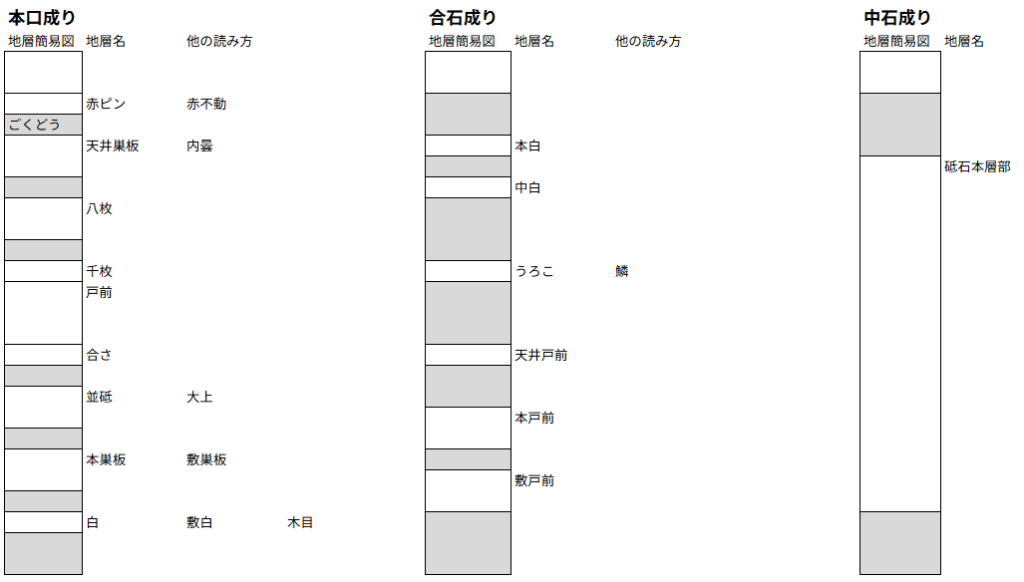In my previous blog entry, I wrote about the peculiarities of geological formations in the suburbs of Kyoto. However, if we look more closely at the geological formations even in the Kyoto area, we can see that the formations vary greatly. The “individuality of natural whetstone” is very important for finishing kitchen knives and planes.
Among them, the difference between “eastern” and “western” whetstones is often heard. This distinction, which has long been used by whetstone enthusiasts and craftsmen in Kyoto and elsewhere, is actually rooted in the difference in strata, or the difference in the stones themselves.
In this page, we will compare the so-called “eastern” quarries, including Nakayama, Daitori, and Okudono, and the so-called “western” quarries, including Maruoyama, Ohirayama, and Ikenouchi, to find out why and how the sharpening quality varies from one quarry to another. The lecture will delve into the differences in the geology of the quarries in terms of geology, grain size, water absorption, and other factors.
Difference between “East” and “West” in terms of geological structure

🔵 Eastern (Nakayama, Okuden, Otsu, etc.)
- Geology: Honkuchi-nari
- Rock: slate
- Origin: Metamorphosed deep-sea mud containing radiolarians
- Layered structure: beautiful stratigraphy with a series of door fronts → nest plate → car entrance.
- Characteristics: Undergoes low to moderate metamorphism and particles remain uniform without recrystallization
Azuma Mono contains a high density of very uniform and fine radiolarian-derived particles, which give it a superb sliding feel and a fine finished surface that can withstand even razors. It is, so to speak, the “royal road to precision polishing.
🔴 West (Mt. Maruo, Mt. Ohira, Ikenouchi, etc.)
- Geology: Aishinari
- Rock: Unmetamorphosed sedimentary rock close to shale and mudstone
- Origin: Mud and volcanic ash deposited in shallower waters and around land
- Layering: somewhat intermittent, with many variations in lithology
- Characteristics: Little metamorphism, strongly influenced by natural weathering and volcanic ash
The western stones are more abrasive and have a slightly harder edge. However, because of this, they are prone to variations in grain size and roughness in the grinding feel, and users’ preferences may differ.
2. difference in grain size, hardness and polishing feel
| (data) item | eastern goods | westerner |
|---|---|---|
| Grain size (average) | 0.1 to 0.5 microns (extremely fine) | 0.5 to 1.5 microns (slightly coarse) |
| hardness | Medium to hard | medium-hard to hard-lip |
| water absorbency | low to medium | Middle to High |
| Crackability | Very easy to split (cleavability ◎) | Hard to crack as a single piece of wood |
| Suitable for | Mirror finish, razor, carving knife | Practical knives, stainless steel knives |
| Appearance | Beauty of layers, asagi, nest plate, etc. | Purple color system, lotus flower, cloudy pattern, etc. |
3. compatibility with steel materials and tips for selection
In actual sharpening, the biggest concern is “which whetstone fits what kind of steel?” is the most important question in actual sharpening.
Regardless of whether it is from the East or the West, the character of the whetstone differs even if it is a few centimeters away from each layer. It is one of the fun to have both East and West whetstones and use them for different purposes according to the steel material of your knives and how you want to finish them. For example, Maruo-yama, one of the western types of whetstones, may seem a little softer than the eastern and western types, but if you look vertically at the strata in Maruo-yama, each type of whetstone has its own characteristics. Finding the whetstone that best suits your taste is one of the pleasures of the whetstone swamp.

*The following is a summary of the classification of the strata again.
| Classification. | feature |
|---|---|
| Hon Ishinari | Belonging to a relatively old formation, the layers are thick and stable, and there is little variation in quality. Nakayama and Okudono are representative examples. |
| Composite stone | The strata are new and highly variable due to the deposition of various layers. This includes the front of the ceiling door and the front of the threshold door. |
| Nakaishi-nari | A classification that falls between the main stone formation and the composite stone formation. |
Geologically speaking, it is located in a layer close to the syngonal formation, but it has excellent stability and quality in actual use, so its feel is similar to that of Honseki nari at Nakayama and other areas. On the website of a company that mines many Maruoyama whetstones, Maruoyama is described as Honseki-Nari. Because of the existence of hybrids such as Maruo-yama, I do not think it makes much sense to divide the complex geological formation into three broad categories. However, I would like to conclude with a word of caution to avoid narrow-mindedness: No toishi, No life. I hope that you will find a wonderful relationship between you and natural whetstones.
summary
| Characteristics of the East | Characteristics of the West |
|---|---|
| Uniform particles, smooth sharpening feel | Varying grain size, practicality-oriented |
| Slate of Honkuchi-Nari | Ligneous mudstone and shale |
| Suitable for mirror finishing and precision cutting tools | Practical blade, suitable for stainless steel |
| Clear layer structure and easy processing | Expressive, colorful, and patterned. |
| Good blending with steel, ideal for finishing | Effective for blade setting and mid-finishing |
Neither East nor West is superior to the other, but each has its own role and appeal.
You ask yourself, “What do I want in a finish?” ─ ─ The whetstone you choose depends on that. Different strata produce different sharpening results. It can be said that nature has created an “aesthetics of different use”.
